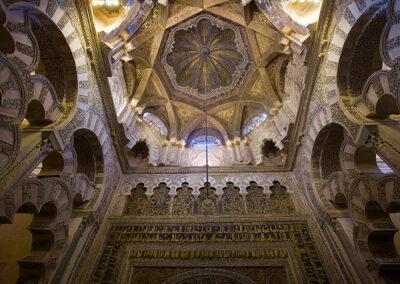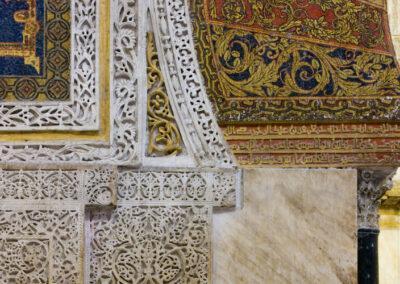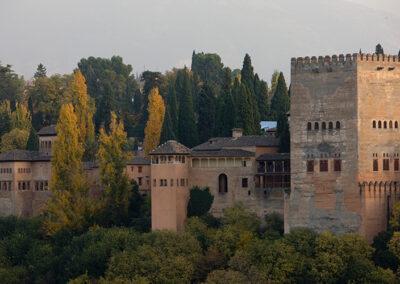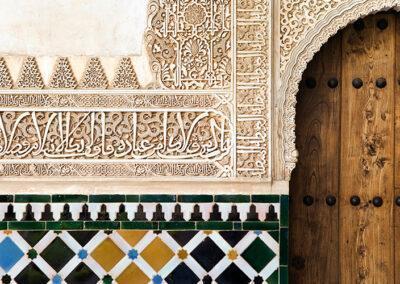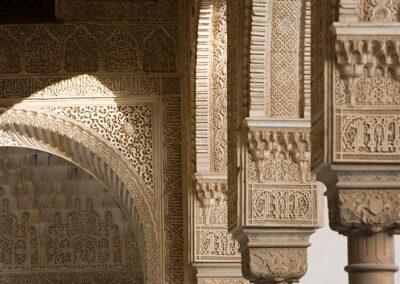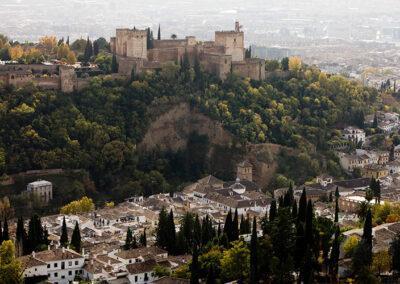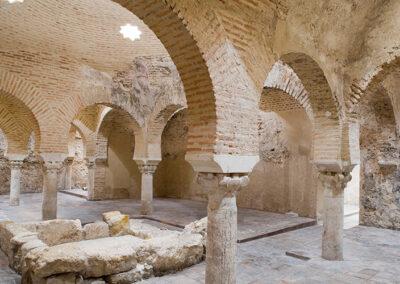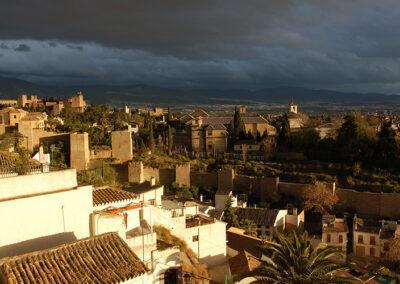
Art and Architecture
of al-Andalus
During the first period of Islam, there soon appears a rich and varied art form, based on classical tradition, on Byzantine art, on Persian art and on that of subdued oriental tribes. However, the originality of architectural structures and ornamental motifs result in a particular art form, typically Muslim. There is an unquestionable common relationship, cultural denominator and vocabulary common to all Islamic artistic creations.
Ornamentation is, without a doubt, one of the aspects that has most contributed to the unification of Islamic art. The same decorative themes appear in architecture, as well as in the decorative arts, notwithstanding the material, scale or technique used. The large profusion of decorated surfaces results in partly camouflaged structures, while through the repetition of motifs, which are often geometric and the studied combination of materials and textures, a three-dimensional effect is produced, providing the buildings with a certain mysterious aura and lightness. Light and water are indispensable elements for this illusive effect. In building, as well as in decorative objects, calligraphy, geometrical motifs, twined stars and stylized leaf motifs fill spaces in harmonious relationship.
Figurative motifs often appear in domestic objects, contrary to the popular belief that Muslim tradition forbade them. Although not actually forbidden, they were not advised, for divinity would lose its transcendental and immaterial character on being there are never figurative decorations in religious buildings. Another of the most characteristic architectural decorative elements are the mocarabes –muqarnas– that separate certain spaces, consisting of semi-spherical or prismatic cells that are repeated and superimposed, creating a veritable hive.
As regards as the decorative arts of al-Andalus, the beautifully carved ivory chests and jars are worth mentioning, and so are the bronze mortars, incense burners and taps, carved wood articles; dishes, glazed earthenware bowls, jugs and basins, the marble ablution basins and lapidary pilasters, gold ware, embroidered silks and bound and illuminated books.
There are many andalusi buildings that may be seen in the Iberian Peninsula. Among those with a religious function there are the mosques. Among the architectural components of the mosques stand out the minaret, from where the muezzins call to prayer five times a day, the courtyard or sahn, where the fountain for ablutions is placed, the covered sector of the mosque, called haram, usually a large place with other aisles perpendicular to the qibla. The end aisles are sometimes extended to surround the courtyard. The wall of the qibla indicates the orientation, usually towards Mecca, and hosts the mihrab. Among the largest mosques that were built in al-Andalus there is the one in Cordoba, and among the more humble ones, that at Almonaster la Real, turned into a church nowadays.
Another of the more characteristic buildings in the Islamic world are the medersas or madrazas, where religious science and law were taught. In olden times, four large rooms or iwans led off a central courtyard, onto which the students’ rooms also opened. A part of the madraza at Granada still exists, but the most spectacular ones are the Merinid ones at Fez, especially Bu Inania.
Among the religious buildings, there were also many mausoleums where kings and the pious were buried which were usually square and covered by domes.
Under military architecture, we should mention the fortification of towns by walls that have regularly spaced defensive towers. They are usually preceded by a barbican and have battlemented parapets. Gates are sometimes set at angles. The walls of Niebla and Seville are worth of mention. The Alcazabas –fortresses– are typically defence buildings which may enclose entire towns, as is the case of Malaga and Almeria. In residential architecture, we have palaces and alcázares, some of them as luxurious as the Alhambra and that at Madinat al-Zahra, near Cordoba, an authentic palace-citadel.
Another of the features of Hispano-Muslim architecture is the large quantity of baths or hammam, essential for the hygiene, but also accomplishing many other functions, such as religious or social ones. Derived from the classical hot baths, they consist of several rooms where the temperature varies progressively. Air is heated underground by means of large cauldrons. Ronda and Jaen have magnificent examples, although more than one hundred baths still remain throughout the Iberian Peninsula.
Lastly, we must not forget to mention the alcaicerías, or qisarias, enclosed spaces within the market-places, where the best merchandise is sold. In this context, it is interesting to mention the refurbished alcaicería at Granada. The alhóndigas (corn exchange) or funduq, were used to store produce and to accommodate merchants. There is still an example of this at Granada: Corral del Carbón.
History
Chronology
Art and Architecture
The Scientific and Cultural Legacy
Daily Life
Glossary


